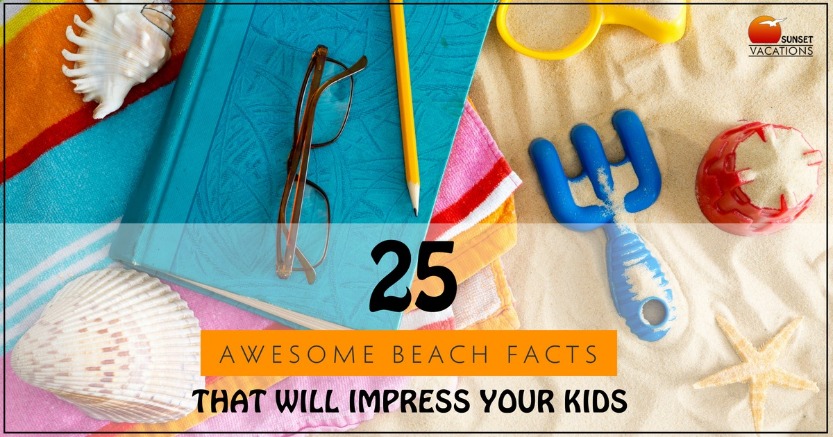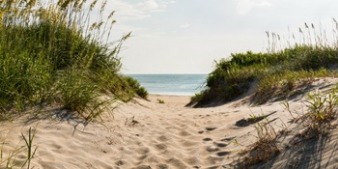25 Awesome Beach Facts That Will Impress Your Kids

When you think of Sunset Beach, what immediately comes to mind? If you're like most of us, your first thoughts are likely along the lines of rest and relaxation. Maybe you think of water sports or even fabulous local cuisine. No matter what, it's likely that your initial focus is on how we as humans use and enjoy the beach.
Yes, the beach is made up of sand and sun and salt and seashells, but when we step back to look at it from a bigger perspective, the beach really is a vastly complex system of living creatures and environmental systems. The beach is eternal, with its own culture and storied history.
Think you already know all there is to know about the beach in general? Test your existing knowledge with this National Geographic beach quiz! Then learn even more about beaches (North Carolina beaches in particular) by reading our post below which contains 25 awesome facts about different facets of the beach that you can use to impress your friends and family!
25
The North Carolina coast comprises 300 miles of barrier island beaches. The Brunswick county area in particular is known for family-friendly beaches, film production, and fabulous historic and contemporary attractions.

24
Barrier islands are long, narrow strips of sand with inlets at either end. Almost all of the ocean-facing beaches in North Carolina are barrier island beaches. The size and position of these islands have moved and changed over the course of history as a result of sea level changes.
23
The sea level rises and falls twice each day along the coast. These high and low tides occur because of the pull of the Moon's gravity. High tides bring shells and other sea treasures closer to the Sunset Beach shore, and low tides often reveal them! Check out your Sunset Beach vacation tide schedule here!
22
Spring tides happen when the Sun and the Moon are lined up and their combined gravitational pull upon the ocean water is at a maximum. These kinds of high tides happen during the full moon and the new moon and result in high tides that are especially high and low tides are especially low.
21
Hermit crabs do not have shells of their own. They simply borrow empty shells to protect their soft bodies. When they outgrow their temporary shelter, they abandon it and seek a new place to live. These crabs have even been known to seek shelter in coconuts!
20
Sea horse babies come from male seahorses!
Adult male seahorses store eggs in their front pouches. When the eggs are ready to hatch, the male simply releases the babies out into the water. These births can result in hundreds if not thousands of baby seahorses!
19
There are thousands of different types of fish on our planet! Almost all of these fish are covered in scales and use fins and a tail to make their way through their native waters. Fish also have slits called gills that they use to "breathe" in oxygen from the water in which they live.
18
Sea turtles come ashore only to lay their eggs. Female sea turtles return to the beach of their own birth in order to lay their eggs. Once the eggs are laid, the mother turtle covers the nest and returns to the ocean. Once the babies hatch, they head straight for the ocean too!
17
North Carolina is home to 5 out of 7 of the world's sea turtle species! Most common are the green sea turtle, loggerhead and Kemp’s Ridley followed by the leatherback and hawksbill. All species are listed as endangered or threatened and are therefore protected under the Endangered Species Act.
16

Hammerhead sharks are named such because of their distinctive head shapes. Each side of their hammer-shaped head has both an eye and a nostril. They hunt by sweeping their head from side to side, using both sides to detect prey. These sharks are native to North Carolina.
15
Orcas, also known as killer whales, are actually the largest members of the dolphin family! These giants of the sea eat their prey with teeth that can grow as large as 4 inches long! These predators often play with their food by tossing it into the air and catching it before they eat it.
14
Have you ever wondered how ocean animals find their way? Scientists think that they use lots of different methods. Some animals may use the currents, while others may use the magnetic force generated by the Earth. Still others may use the Sun, stars, and other landmarks to guide them.
13

Pearls are just super fancy grains of sand! If a grain of sand gets stuck inside an oyster's shell, the oyster soothes itself by coating that grain of sand with a substance called "nacre." Over the course of time, the nacre builds up and a pearl is formed!
12
Most ocean waves are caused by winds scraping against the surface of the water. For these types of waves, the wave that you see is really just energy from the air transferring to the water. While the energy may move great distances across the ocean, the water itself generally does not move far.
11
Undertow and rip current are not the same thing!
Rip currents are the #1 safety threat at beaches! Rip currents WILL pull you out into the ocean. These currents are powerful and dangerous.
Undertow is essentially the backwash that occurs on the beach when a wave has come ashore and the water is filtering back into the ocean. Undertow may knock you down but will not pull you out into the ocean.
10
More than 2,000 ships have sunk off the coast of North Carolina, thereby earning this stretch of ocean the nickname "The Graveyard of the Atlantic." Notoriously strong currents, dense patches of fog, and bouts of maritime warfare (including pirate activity!) have all contributed to this grim tally.
9

Edward Teach - also known as Blackbeard - was one of the most fearsome pirates to haunt the eastern seaboard. He and his fellow racketeers spent quite a bit of time along the barrier islands of North Carolina, enticed by beautiful scenery, thriving trade, and ample waterways (i.e. escape routes!).
8
Sunken treasures aren't the only valuables guarded by the ocean. Minerals such as oil, gas, and salt are all commodities held by the sea. In addition, fishing is a multi-million dollar global business and other commodities such as pearls and sea sponges can also fetch a pretty penny.
7
North Carolina has seven coastal lighthouses, ranging from Currituck Beach in the north to Bald Head Island in the south.
Six out of seven of them are open for tours during the summer months. Learn when you can go explore them here!
6
Natural beach sand in North Carolina is an ancient and finite resource. NC beaches are made up primarily of organic materials that traveled from the Piedmont to the coast via now non-existent rivers when sea level was much lower than it is now. This process took millions of years.
5
NC beach sand is comprised of two main materials: shell fragments and minerals. The main mineral found on North Carolina beaches is quartz, and usually accounts for about 80%-90% of the mineral-based sand. Feldspar is the second most common mineral making up NC beach sand.
4

The North Carolina state shell is the scotch bonnet. Found primarily in the Outer Banks between Cape Hatteras and Cape Lookout, these delicate shells earned their name due to their resemblance of a traditional Scottish woolen cap. Scotch bonnets feed on sand dollars!
3
Many of the shells that you find on NC beaches are hundreds if not thousands of years old. These shells most likely arrived onto our modern day beaches as the result of barrier island migration (see #24 above). This means that when you're shelling in NC, you're fossil collecting too!
2
Trash, packaging, and improperly disposed waste from sources on land accounts for 80% of the marine debris found on beaches during cleanups and surveys. The other 20% of items making up marine debris are attributed to at-sea losses from accidental or deliberate discharges from ocean-going vessels, and from lost or abandoned fishing gear and traps.
1
Sunset Beach was recently recognized by National Geographic as one of the top beaches IN THE WORLD!
That's right, folks. Our local slice of heaven is listed along with luxurious destinations such as Australia and Hawaii.
But the fact that Sunset Beach NC is one of the best beaches here on Planet Earth is probably something that you already knew...right?
We hope this round-up of 25 awesome beach facts both impresses your kids AND gets you in the mood to book your Sunset vacation rental ASAP!
We'd love to know which one of these facts you liked the best. Share your opinion in the comments below!

Did you learn something new by reading this post? Please show your appreciation by SHARING this post with your friends on social media!










